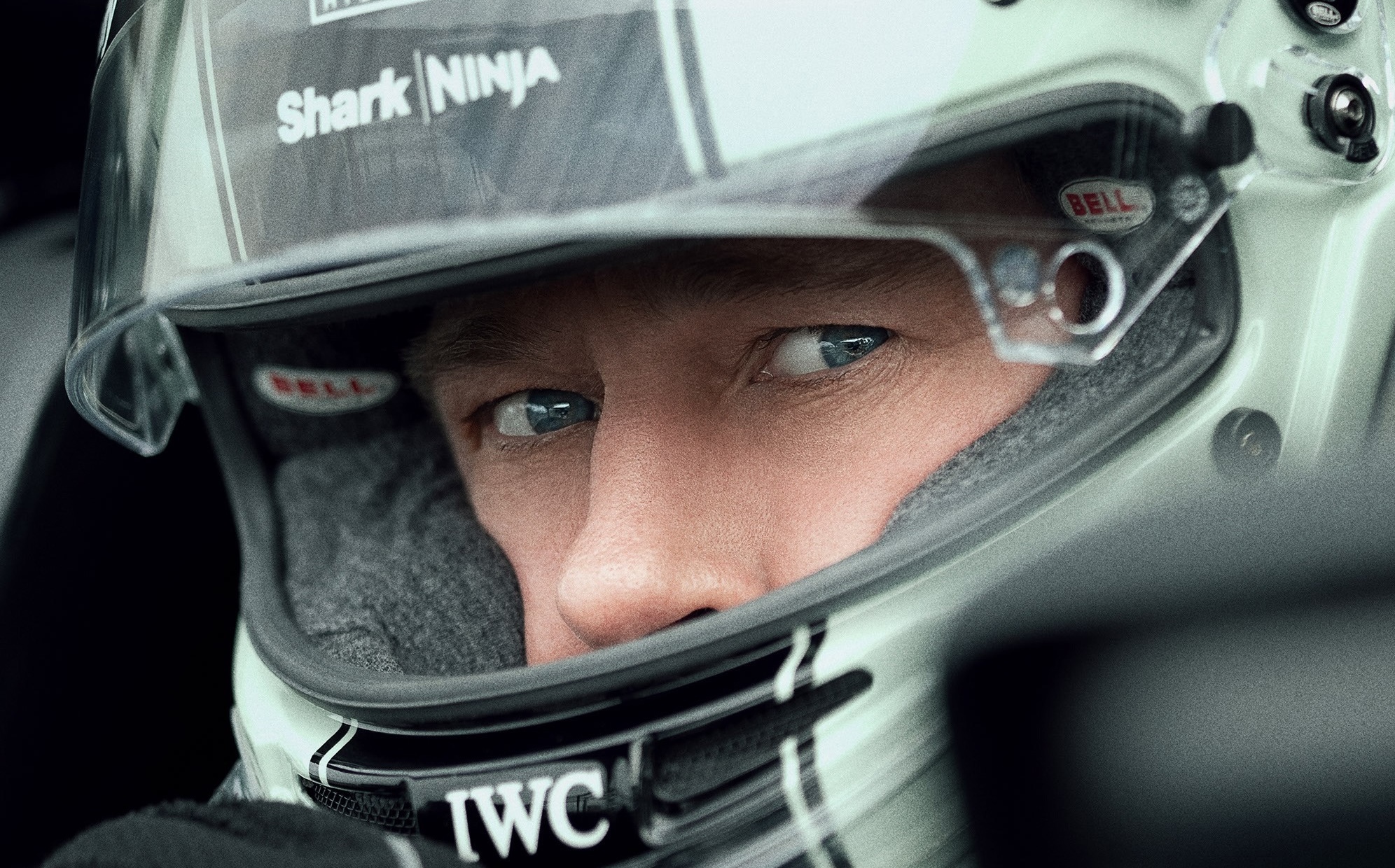In a clever flex of corporate synergy, Apple promoted its first summer blockbuster with the release of a haptic trailer that imitates the purr of an F1 engine in the palms of your hands. The clip delivers such well-calibrated vibrations that watching it on an iPhone makes it seem like you’re microdosing 4DX right on the subway, or the toilet, or wherever it is you choose to enjoy the film industry’s latest breakthrough in vertical integration.
But the real potency of this ad, and the real potential of the technology that it represents, can only be experienced by viewing the promo on mute — the haptic feedback is so nuanced and expressive that you can literally feel the basic plot and emotions of Joseph Kosinski’s “F1” through your fingertips. It’s the closest thing to “pure cinema” I’ve ever enjoyed on a device that I primarily use for playing Marvel Snap and Googling answers to my five-year-old son’s trivia questions (yes, a rhino could outrun Usain Bolt).
How disappointing, then, that the film itself manages to offer so little of the same thrill, despite the benefit of booming Dolby speakers, the scale of an IMAX screen, and the sleekness of a director whose aesthetic naturally cleaves towards Apple commercials (see: “Oblivion”). That’s certainly not for lack of trying.
Determined to bring the same you are there verisimilitude to race cars that they did to fighter jets in “Top Gun: Maverick,” Kosinski, cinematographer Claudio Miranda, and superproducer Jerry Bruckheimer have gone to extraordinary lengths to capture the essence of F1 — lengths that include turning Brad Pitt and co-star Damson Idris into legit Grand Prix drivers, attaching hi-def micro-cameras to the frames of their vehicles as the actors whipped around the world’s most famous tracks, and filming at the actual events that are depicted in the movie.
Not only was the fictional APXGP team granted its own garage right between Scuderia Ferrari and Mercedes, but the pre-race party Idris’ character attends before the tour’s Las Vegas pitstop is even hosted by the real DJ Tiësto! “F1” is far too sincere in its crowd-pleasing ambitions to feel like a fully licensed piece of $200 million sponcon, but the movie’s commitment to authenticity extends to every aspect of its titular sport, both on the track and off, as its mission to win over new converts is only outdone by its eagerness to satisfy diehard fans.
Alas, Formula One has always been a testament to the difficulty of striking the right balance between power and precision, and “F1” embodies that aspect of the sport all too well. Always entertaining for how effectively it welds hyper-modern spectacle to the chassis of a classic underdog story (the latter part of that equation paving the way for Pitt’s most Billy Bean-coded performance since “Moneyball”), Kosinski’s film can be propulsive and exhilarating in spurts, but in working so hard to satisfy newbies and experts at the same time that it often struggles to seize on its simplest pleasures. Misfits becoming teammates. Losers finding redemption. Cars going really, really fast.
All of these things are key parts of the mix, but for a movie so preoccupied with the difference between sound and noise (what’s relevant to a racer at 200 M.P.H. vs. what they need to tune out), “F1” often fails to lock in on what really matters to its defining moments — a frustration that’s reflected in everything from character arcs and backstories to shot selections and the incessant use of broadcast-like color commentaries. Your whole body will vibrate for the better part of this film’s speedy 156-minute running time, and few other blockbusters this summer will be more fun to experience at a level of volume that you can’t get at home, but loudness is a sad consolation prize for a movie whose own trailer didn’t need any sound at all to better capture the flow state that its protagonist lives to chase.
Sonny Hayes (Pitt) hasn’t enjoyed the most storied of professional racing careers, but you can tell from his name alone — a perfect movie name — that he was born to be in the driver’s seat, and that he doesn’t belong anywhere else. A future star of the F1 circuit until a devastating 1993 crash turned him from a “will be” to a “never was,” Sonny has spent the last 30 years as a wandering samurai who’s taken any job that came attached to a pair of wheels, from a stock car racer to a New York City cab driver.

Somewhere between a stoic Western archetype and a shit-eating myth, he lives in a van where he can suffer hotly in peace. The money never mattered to Sonny (he only needed enough to support his gambling addiction), and winning has always been little more than a means to an end — the shortest path to the self-actualization that he gets from being one with the road. Except, three decades of feeling like a loser seems to have taken its toll, and the first thing he tells his Daytona teammate in the film’s opening scene is that he’ll kill him if the guy blows their lead.
This is as much insight as we’ll ever get into the tao of Sonny, but it’s enough to understand why he hesitates when his old racing buddy Ruben Cervantes (Javier Bardem), now the desperate owner of the worst team on the F1 circuit, shows up with an unprecedented offer for a washed-up 60-year-old nobody: Become the not-so-new face of APXGP and save what’s left of their season so that Ruben doesn’t lose the company. It’s a hail Mary, and Sonny isn’t sure the risk of embarrassment is worth the paycheck that comes with it, but he can’t turn down the chance at the glory that once got away from him and/or the chance to drive the world’s fastest cars.
And so, before we even get to the title card, Ehren Kruger’s sleek and sturdy script has already put the story’s foundation in place. All that’s left is for Sonny to spar with APXGP’s hotshot rookie driver (an instantly compelling Idris as cocky London native Joshua Pearce, all flash to Sonny’s zen-like calm), make eyes at the sport’s first female technical director (the ever-appealing Kerry Condon, squeezing worlds of personality out of a human plot device), and learn to get out of his own way as he comes to appreciate that F1 is a team sport. A few other bits take shape in the margins, including a garbled subplot involving Tobias Menzies as a techbro financier and some “Ted Lasso”-adjacent hijinks with APXGP’s winsome pit crew (unrelated to “Lasso” alum Sarah Niles’ performance as Joshua’s mom), but “F1” is generally as straightforward and predictable as any of the nine different tracks that Sonny zooms around over the course of the film.
In theory that should work to the benefit of this vintage Bruckheimer vehicle, and occasionally it does. The simplicity of the film’s story makes it easier for Kosinski to accommodate the arcane nature of F1’s rules, even if he never finds a satisfying way to incorporate them on the fly, and — similar to Kruger’s script for “Maverick” — the lack of a clear villain for most of the movie allows the focus to remain squarely on the main characters, who are racing against each other and themselves to a much greater degree than they are any of the drivers from rival teams.
But where “Maverick” was able to support that focus with decades of baked-in pathos, “F1” is forced to rely on the ample charms of its cast. While no one will ever get bored watching Pitt and Idris push each other’s buttons, there isn’t exactly a world of depth behind Sonny’s leathered renegade schtick (it’s a bit tiresome how many times he races outside the lines without alerting the rest of his team), just as the complexities of Joseph’s arrogance are mostly hidden in the folds of Idris’ performance.
More frustrating is that the actual racing sequences are less expressive than the dialogue scenes. While the realism of the film’s grand prix events is obviously second to none (silly as some of Sonny’s rule-skirting gambits can be), and Kosinski has a proven track record of making speed look even cooler in the movies than it does in real life, “F1” makes the mistake of trying to reconcile the experience of driving Formula One with the experience of watching it on TV.
The most obvious symptom of that is the aforementioned broadcast commentary, which narrates literally everything that happens during the races. In large part, that’s a necessary evil of a film that has to explain how placing, safety cars, and tire grades work to an audience of neophytes in real-time. But in order to disguise the expository function of the commentary and affirm the authenticity of the average fan’s F1 experience (which is to say: enjoying the races from their couch rather than the stands), the narration is also prone to saying things like “Sonny has fallen to last place! That’s not going to make AXPGP happy.” On TV, that sort of color helps confer a narrative onto unconstructed reality. In the context of this movie, it crushes the reality out of a constructed narrative.
The driver’s seat of an F1 car is pretty small to begin with, and Kosinski’s film — which constantly defaults to a “Star Wars”-like cockpit shot in order to show us Sonny’s face while proving that Pitt is actually behind the wheel — leaves viewers precious little space to engage with the film’s characters on their own terms. The emotional impact is so blunted that our only choice is to surrender to the booming spectacle of it all (Hans Zimmer, take the wheel), but even that proves difficult in a film that never quite solves how to handle the sameness of a 44-lap race.
Kosinski is limited to 15 camera positions on each car, few of which capture anything more than wheel-to-wheel intensity, and he compensates for that lack of choice by restlessly cutting between them. It’s as if the film is trying to reflect Sonny’s agitated pursuit of clarity amid the chaos (a suspicion that’s strengthened by subtle changes in the editing towards the end), and every merciful retreat to a top-down angle feels like a concession to the fact that Kosinski hasn’t found a more satisfying way to shoot F1 than they do on TV.
The action is hardly dull, but the sheer disconnect between the wowee zowee immediacy of the race footage and the mezzo mezzo excitement it inspires suggests that tuning out the noise isn’t as easy as Sonny Hayes might seem to think. “Sometimes when you lose, you win,” Ruben tells his old friend. And sometimes when you win, this solid but underwhelming blockbuster contends, you still lose.
Grade: C+
Apple Original Films and Warner Bros. Studios will release “F1” in theaters on Friday, June 27.
Want to stay up to date on IndieWire’s film reviews and critical thoughts? Subscribe here to our newly launched newsletter, In Review by David Ehrlich, in which our Chief Film Critic and Head Reviews Editor rounds up the best new reviews and streaming picks along with some exclusive musings — all only available to subscribers.



